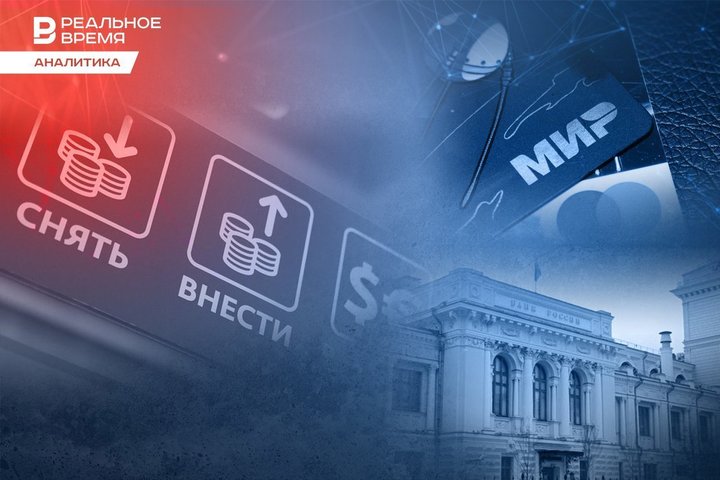Deposits at historical highs: will the growth continue?

Tatarstan residents keep 1.2 trillion rubles in deposits. Over the past year, the amount of savings has increased by more than 26%. According to the Central Bank of Russia, the volume of household funds in credit and financial institutions in the country increased by 26.1% last year to 57.5 trillion rubles. So, the dynamics of the indicator in Tatarstan practically coincides with the national average. Today, bank deposit rates are at a historic high. Whether interest rates will continue to rise in 2025 and how to respond to rumours about the freezing of all deposits is in the review of the analytical service of Realnoe Vremya.
2025 will be the year of the depositor
At the beginning of January 2025, the savings of Tatarstan citizens amounted to about 1.2 trillion rubles (excluding funds in escrow accounts). Compared to the beginning of last year, this amount increased by more than 26%, the National Bank of Tatarstan told Realnoe Vremya. In just six months, the volume of household deposits has grown by almost 200 billion rubles. According to the National Bank, in the first half of the year, Tatarstan citizens kept just over a trillion rubles in their accounts. In addition, the dynamics of fundraising accelerated, with an increase of 23% as of July 1.
However, this was a predictable result against the background of a record increase in the key rate. Contrary to the expectations of banks and other market participants, who at the end of 2023 expected a reduction in the Central Bank's key rate in the second half of 2024, the regulator not only did not lower it, but launched a new round of increases in the fight against inflation. As a result, from the end of July to October, the rate was raised from 16% to 21%, a new historical maximum. From the December meeting, most experts and analysts expected a rise of another 2 percentage points, to 23%, but the regulator surprised market participants by keeping the rate at 21%.
Due to the tight monetary policy of the Bank of Russia, they were forced to actively raise deposit rates. The average maximum interest rate of the top 10 credit institutions increased by almost 7 percentage points over the year to 21.687%.

Absurd and inconceivable rumours
Against the background of such popularity of deposits on the Internet, rumours have appeared about a possible freezing of bank deposits.
“This idea is absurd. Apart from that this is a gross violation of the right of citizens and companies to dispose of their assets, such a step would undermine the foundations of the banking system and the financial stability of the country," the Bank of Russia stressed. “Banks attract free funds from the public and companies. This is the only way they are able to provide loans to borrowers. If you “freeze” deposits, limit the ability for citizens and businesses to manage their money, then no one will be ready to keep money in banks. And this will immediately put an end to the banks' ability to lend to the economy. It is quite obvious that in any market economy, of which bank lending is an integral part, such a step is unthinkable.”
If you “freeze” deposits, people will lose confidence in banks and the financial system as a whole for a long time. And instead of continuing to deposit their savings, they will rush to invest them in real estate and durable goods. With corresponding unfortunate consequences for price increases. The key rate will stop working, and the Central Bank will lose its main instrument of influencing demand and inflation. It's even worse than sawing off the branch only you're sitting on. It's like reaching the middle of a bridge stretched over a deep gorge, and with one swing of an axe, you cut through the ropes that hold it, the Central Bank explained.

Fears that at some point savings will spill out into the consumer market at once and inflation will soar are groundless. The willingness of citizens to save money on deposits directly depends on the ratio of the key rate and people's expectations for future inflation. The Bank of Russia will reduce the level of interest rates in the economy gradually, only after making sure that inflation and inflation expectations are steadily decreasing. Such policy will support the attractiveness of deposits. As a result, consumption growth will be influenced not so much by the use of already accumulated deposits as by the use of a larger share of income. And this will not prevent a decrease in inflation.

The government has many other ways to cover the budget deficit, such as raising taxes, weakening the ruble, and simply issuing money. “In the end, all this will also negatively affect the purchasing power of citizens' savings, but still it is not such a radical and shocking option," he believes.
“In my opinion, the argument that banks may not have enough money to pay interest on deposits that have grown significantly over the past year is also not very convincing. The assets of banks in the form of loans to the public and businesses, government and corporate debt securities have also grown significantly, and this will allow them to continue generating significant revenues in their main areas of activity," Igor Dodonov comments. “Although some pressure on the net interest margin of banks is probably to be expected. At the same time, it should be noted that last year the sector earned a record 3.8 trillion rubles in net profit. This year, profits are likely to decline, but will remain quite high by historical standards. In addition, according to the Central Bank, the capital reserve in the sector (up to standards) as of the end of December amounted to a very significant 7 trillion rubles," Dodonov continues.
“Therefore, I would advise you not to pay attention to such rumours," he advises.

Rates will remain at an attractive level
According to the Central Bank of Russia, the volume of public funds in banks in the country increased by 26.1% last year to 57.5 trillion rubles. So, the dynamics of the indicator in Tatarstan practically coincides with the national average. An increase of 26% can be estimated as very significant, for comparison, by the end of 2023 it was about 19.7%.
Further dynamics of deposit rates will largely be determined by the monetary policy in the country. At the same time, the probability of their decrease, in my opinion, is still greater than the probability of growth.
“At the meeting in mid-February, the Central Bank will not change the key rate again, so I would not expect any significant adjustments to deposit rates in the coming weeks," Igor Dodonov notes. “I think that somewhere in the middle of this year, conditions may develop in the country for the beginning of a reduction in the key rate. Moreover, this process, when it begins, will take place gradually.”
Deposit rates may start to decrease a little earlier, but it will also happen quite smoothly. “That is, deposit rates, although most likely, will no longer show any significant increase, but, most likely, they will remain at a fairly high and attractive level for a long time," he concluded.

The future interest rate environment on deposits will be completely determined by the dynamics of the key interest rate. The Bank of Russia has announced a prolonged period of tight monetary policy, so Expert RA does not expect a sharp decline in the base indicator in 2025. The monetary authorities are talking about individual signals for a further increase in the key rate, but recognise the need for longer observations of the effect of decisions already taken.

“We expect to maintain high deposit yields throughout 2025, given the low probability of a key rate cut in the first half of the year. However, even in the case of monetary policy easing, the process of lowering the key rate will not be abrupt, and therefore deposit rates will remain attractive to customers," the expert concluded.